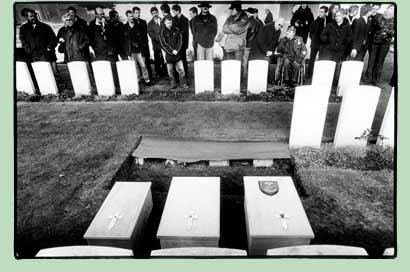 THE HERITAGE OF THE GREAT WAR
THE HERITAGE OF THE GREAT WAR

 Burials in Flanders fields
Burials in Flanders fields 

 Cement House Cemetery, near Langemark in Flanders. Burial of three unknown soldiers, November 2005
Cement House Cemetery, near Langemark in Flanders. Burial of three unknown soldiers, November 2005
Click on the picture to start a slides show
Pictures by
Text by Rob Ruggenberg 
 A cold November morning in Flanders fields where between the crosses, row on row, fresh graves wait. It is burial day. A few times a year corpses and smaller human remains, recently found, are given back to the earth.
A cold November morning in Flanders fields where between the crosses, row on row, fresh graves wait. It is burial day. A few times a year corpses and smaller human remains, recently found, are given back to the earth.
Here, at Cement House Cemetery near the village of Langemark, the day starts with the burial of three unknown soldiers, whose remains were found by the Boesinghe Diggers in an industrial zone near the canal at nearby Boesinghe.
These Boesinghe Diggers are Flemish archeology amateurs, all fascinated by the Great War, all devoted to dig up as much as possible, while it still can. The industrial zone is expanding and the diggers excavate sites where soon factories will be built. Now and then they find human bodies.
 Click on one of the small photo's below - and you'll get the full picture.
Click on one of the small photo's below - and you'll get the full picture.

|
|
Final Rest
In 1915 the whole area near the canal at Boesinghe was battlefield, Patrick van Wanzeele explains. He is one of the Boesinghe Diggers. Every Saturday he and his friends dig up former trenches. They use old trenchmaps to locate Nomansland and the frontlines.
The coffins are small. There was not much left of the three unknown men who are buried today. Near one of the the bodies a shoulder patch was found: Somerset Light Infantry. That is all we know.
Yes, they find German bodies as well, Patrick tells. Germany buries all mortal remains that are found in a massgrave at the German Langemark War Cemetery.
In 2005 about 25 German soldiers were buried in this way, all on one day.
|

|
|
Service
The second burial ceremony of today takes place at Track X Cemetery, close to Ypres.
Chaplain Ray Jones of St. George's Memorial Church at Ypres conducts the service.
"Dust thou art and unto dust shall you return."
Only one coffin here. The name of the soldier is unknown, we know only that he belonged to the Royal Sussex Regiment. His body was found by official Belgian archeologists who are excavating the terrain where the new Highway A19 is supposed to come.
|

|
|
Last Post
Two buglers from the Ypres Fire Brigade sound the Last Post.
|

|
|
The last coffin arrives
A gravedigger of the Commonwealth War Graves Commission arrives at the third war cemetery where a burial is going to take place today: Wulverghem-Lindenhoek Road Cemetery, south of Ypres.
All allied war graves on the European continent are maintained by this organisation.
|

|
|
Rehearsel
Still one hour to go before the ceremony will commence.
The two British gravediggers rehearse the lowering of the coffin. When the actual burial starts everything has to go flawless. And so it did.
|

|
|
Salute
The unknown soldier buried here belonged to the Worcestershire Regiment. That much we know from the remains of the uniform that were still on his body.
He was found in the court-yard of a nearby farmhouse. The farmer was digging in his garden when he discovered the corpse. It happens all the time. So many are still missing, so many are still buried somewhere in Flemish mud.
On the picture: on the left a representative of the Worcestershire Regiment. In the middle, saluting, a representative of the Belgian armed forces and on the right Philip Noakes, director of the Northern Europe Area of the Commonwealth War Graves Commission.
After the Last Post has sounded, Philip Noakes cites Laurence Binyon:
They shall grow not old as we that are left grow old,
Age shall not weary them, nor the years condemn.
At the going down of the sun and in the morning,
We will remember them.
|
 All burial-pictures are available in high resolution for printing purposes. Please contact the copyright owner
All burial-pictures are available in high resolution for printing purposes. Please contact the copyright owner
![]() Burials in Flanders fields
Burials in Flanders fields ![]()
![]() Cement House Cemetery, near Langemark in Flanders. Burial of three unknown soldiers, November 2005
Cement House Cemetery, near Langemark in Flanders. Burial of three unknown soldiers, November 2005![]()
 A cold November morning in Flanders fields where between the crosses, row on row, fresh graves wait. It is burial day. A few times a year corpses and smaller human remains, recently found, are given back to the earth.
A cold November morning in Flanders fields where between the crosses, row on row, fresh graves wait. It is burial day. A few times a year corpses and smaller human remains, recently found, are given back to the earth.![]() Click on one of the small photo's below - and you'll get the full picture.
Click on one of the small photo's below - and you'll get the full picture.![]() All burial-pictures are available in high resolution for printing purposes. Please contact the copyright owner
All burial-pictures are available in high resolution for printing purposes. Please contact the copyright owner